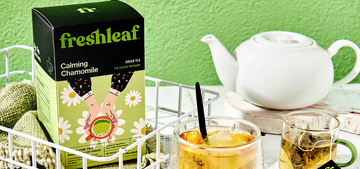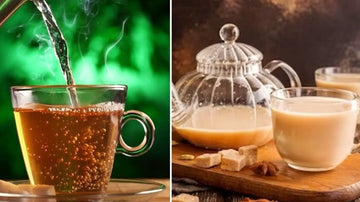Milk first in tea or last in tea? The Science and the Story?
by Lovlesh Saini on Feb 05, 2025
Milk First or Last in Tea?
The Milk First in Tea and the Tea First in Milk have been a topic of debate for a while. Well, it is not exactly a hot topic, but it has been in focus for two centuries, and it has even had people pull our swords (not literally) and families break up ( just making tea in different pots ) over the discussion. Normally it happens only over family gatherings, office pantries, drawing rooms, and online forums alike. Each side insists their way is the correct way. Each side claims their tea tastes better than others. And each side declares an emphatic victory over the other!
It’s even made its way into literature, with none other than George Orwell weighing in on the topic. And, believe it or not, the Royal Society of Chemistry has even thrown its scientific expertise into the ring. So, what’s the real answer? Should we follow tradition, or should we bow to science? Does adding milk first ensure a smoother, more refined cup, or does pouring it in last create a better taste experience? And most importantly, does it even matter, or is this just one of those quirky debates that make the world of tea so wonderfully fascinating?
Now, before you get into it, I wanna talk about something, the next time you brew your tea, take a closer look at the pack. Specifically, check out the brewing instructions. I am fairly confident that brewing instructions will end with “ add milk and sugar to taste “. Well, if you have been adding milk last, the good news is that you are with an overwhelming majority, but I mean, you might be doing something wrong, well, you won’t know until you do. Let’s see if you are on the good side or not.
A Brief History of the Milk-tea War?
The tradition of adding milk to tea dates back to the 17th century when tea was first introduced to Britain, quickly becoming a symbol of sophistication and refinement. At the time, tea was an expensive import, sipped delicately from fragile porcelain cups that, unfortunately, weren’t designed to withstand the heat of boiling water. Well, you might think so, until milk came, the ingenious solution that acted as a buffer, preventing those prized teacups from cracking under the sudden temperature shock.
As time went on, the arrival of stronger, heat-resistant porcelain removed the necessity of adding milk first, but by then, the habit had already steeped into society. More than just a practical step, it became a marker of class distinction. Aristocrats, who could afford fine porcelain, poured their tea first, reveling in the rich aroma and then adding milk to taste. Meanwhile, the working class, using more affordable earthenware, continued to pour milk first to safeguard their cups. Over time, tea tea-drinking elite began to associate milk-first pouring with the less refined, cementing the divide.
And then came the opinions. George Orwell, in his famous 1946 essay A Nice Cup of Tea, proclaimed that adding milk last was the only civilized way to prepare tea. To him, it was an absolute rule of etiquette and taste. But, not everyone agreed. In 2003, the Royal Society of Chemistry ( yes, they actually weighed in on this!) challenged tradition by asserting that, scientifically, adding milk first was the superior method for achieving the perfect cup of tea.
So, who’s right? Is this a matter of taste, tradition, or science?
The Science of Milk and Tea
-
Temperature of Tea Matters: Avoiding the Scalded Milk
Well first and foremost, temperature, because when it comes to tea and milk, things can get a little heated, literally. Tea is typically brewed at high temperatures, anywhere from 80°C to a near-boiling 100°C, depending on the type of tea. But milk? Milk is a bit more delicate. Its proteins, mainly casein, don’t take kindly to sudden temperature shocks. If you pour steaming hot tea directly onto cold milk, these proteins can denature too quickly, changing their structure and affecting both the texture and taste of your cuppa. The result? A slightly burnt, overly cooked milk flavor that tea aficionados would rather avoid. However, if milk is poured first, it gently warms up as the tea flows in, allowing the proteins to adjust more gradually. This prevents that unwanted scalded milk effect and results in a smoother, creamier blend. It’s like easing into a hot bath instead of jumping straight into it, you avoid the shock, and the experience is far more pleasant.
-
Chemical interactions: Tannin in tea
Tea contains tannins, those naturally occurring compounds that give tea its signature bitterness and astringency. They’re the reason your mouth sometimes feels a little dry after a strong brew. While tannins add depth and character to tea, they can also be a bit harsh when left unchecked. Here’s where milk comes to settle the war. Tannins love to latch onto milk proteins, softening their astringent bite and creating a milder, more balanced flavor. When milk is added first, these proteins are already present when the tannins arrive, meaning the bitter compounds are immediately tamed, resulting in a gentler, smoother tea.
On the other hand, if milk is added last, the tannins have already had their moment in the spotlight, fully developing their bitterness before the milk proteins get a chance to intervene. This can lead to a sharper, more puckering taste, something you’ll especially notice in bold black teas like Assam and English Breakfast. So, if you’re after a more refined, mellow cup, milk first might just be the way to go.
-
Taste & Texture: Emulsion of tea
Ever wondered why some cups of tea taste silkier and creamier than others? It all comes down to emulsion, the way the fat droplets in milk mix with tea. When milk is added first, these tiny fat droplets distribute more evenly as the tea is poured in, blending smoothly and creating a luscious, well-rounded texture.
Conversely, adding milk last can lead to uneven mixing. You might find yourself stirring more than you’d like, trying to get that perfect consistency. Worse yet, in teas with high acidity, like bergamot infused Earl Grey, adding milk last can sometimes lead to curdling, and nobody wants a lumpy tea. So, for the creamiest, dreamiest cup, science suggests milk-first might have the upper hand. But does that mean it’s the only way? Not necessarily. Tea drinking is a personal experience, and tradition, habit, and preference all play a role. Still, next time someone scoffs at your milk-first method, feel free to raise an eyebrow and say, “It’s science, darling.”
The Etiquette of Tea Drinking
When it comes to tea, the British don’t just drink it, they ritualize it. The art of proper tea etiquette has been refined over the centuries, and if you ever find yourself at a formal afternoon tea, knowing the rules could save you from a few raised eyebrows.
A simple guideline? If you’re sipping from fine bone china at a post affair, milk-last is the expected choice. This allows the host or hostess to pour the tea first, ensuring the correct strength before milk is added. It’s a subtle nod to tradition, precision, and a touch of tea snobbery. But if you’re in a more relaxed setting, say, enjoying a cuppa in a sturdy everyday mug, adding milk first won’t spark outrage. In fact, in some circles, it’s seen as a sign of practicality and efficiency. Emma, a devoted tea enthusiast from London, once confided, “If I see someone pur milk first, I instantly think one of two things: either they have a delightful rebellious streak, or they grew up in a household where tea was more of an afterthought than a sacred ritual.”
And of course, this debate is largely irrelevant in countries like India, where chai reigns supreme. Here, milk isn’t just added, it’s brewed with tea, spices, and sugar to create a rich, aromatic experience. In this case, milk-first isn’t a question of etiquette, it’s simply the way things are done.
So, really here it comes down to the kind of tea you enjoy drinking.
The Psychological and Cultural Divide
Ever wonder why people are so fiercely loyal to their tea-making rituals? Turns out, it’s not just about taste, it’s about psychology. Experts suggest that our tea habits stem from a combination of cultural upbringing and sheer repetition. If you grew up watching your family pour milk last, chances are that anything else feels downright unnatural. Likewise, if milk-first was the household norm, then seeing someone do it differently might leave you quietly horrified.
A fascinating survey conducted by a leading tea brand revealed that 60% of tea drinkers firmly believe that milk should go in last, while 40% swear by the milk-first method. That’s almost an even spilled, proving that this debate is anything but settled. It’s not just about preference, it’s practically a personality test.
My friend Rohan, a die-hard tea purist, once said, “Milk-first people are just chaos-loving individuals who enjoy watching the world burn. Milk-last folks, on the other hand, appreciate order and balance.” A bit dramatic? Absolutely. But tea has that effect on people. At the end of the day, whether you pour your milk first or last, one thing is clear, tea isn’t just a drink. It’s an experience, a ritual, and in some cases, a battleground of tradition versus innovation.
The Verdict: Science vs. Tradition
So, after all this debate, is there a clear winner? Well, science does give a slight edge to adding milk first, it results in a smoother, creamier texture and helps control the flavor balance. On the other hand, tradition and etiquette firmly stand by milk as the ‘proper’ way to prepare tea, especially in refined settings.
At the end of the day, it really boils down to personal preference. If you’re someone who loves a velvety, well-integrated cup of tea, pouring milk first might be your best bet. But if you enjoy a bolder tea flavor and the aesthetic satisfaction of watching milk swirl into the hot brew, then milk last is the way to go.
The Final Sip
No matter where you stand on the milk-first-or-last spectrum, the beauty of tea is that it adapts to personal taste. Whether you’re a scientist aiming for the perfect emulsion or a traditionalist holding onto etiquette, there’s no wrong way to drink tea, just different ways to love it.
So, what’s your take? Are you a milk-first revolutionary or a milk-last purist? Either way, let’s raise our cups (with or without milk) to the great tea debate that will never truly be settled but will always be deliciously entertaining.


